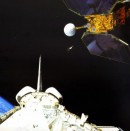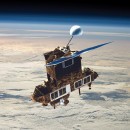When you look at the sky, you only see a bright blue picture with clouds, some planes, maybe the occasional flying bird, and that’s about all. Nothing seems out of the picture, but beyond that, there is what we call space debris.
We are constantly reminded to take care of our planet and how we need to segregate our trash and be mindful of our environment. However, in 2021, the Department of Defense’s global Space Surveillance Network (SSN) reported that there were more than 27,000 pieces of space junk. This orbital debris poses a high risk to future space missions and our satellites, due to their fast travel which can reach speeds of up to 17,500 mph (28,163 kph).
A retired NASA satellite called Earth Radiation Budget Satellite (ERBS) weighing 5,400 lbs. (2,449 kg) is expected to reenter the Earth’s atmosphere on Sunday, Jan. 8, at around 6:40 p.m. EST +/- 17 hours (Jan. 9, 00:40 CET). However, according to specialists, chances are slim that any of that satellite's parts will pose a threat to humanity since most of Earth is covered in water.
“NASA expects most of the satellite to burn up as it travels through the atmosphere, but some components are expected to survive the reentry. The risk of harm coming to anyone on Earth is very low – approximately 1 in 9,400,” NASA stated.
The Earth Radiation Budget Satellite has launched an eternity ago, back on Oct. 5, 1984, from the Space Shuttle Challenger. It was part of the mission called The Earth Radiation Budget Experiment (ERBE). Two other Earth-orbiting satellites were launched beside the ERBS, namely the National Oceanic and Atmospheric Administration (NOAA) satellites.
These three satellites were used to measure Earth’s radiative energy budget and the stratospheric composition. It was the ERBS satellite that collected data and measurements, which helped us discover that the ozone layer was declining on a global scale.
This satellite also studied how several human actions, such as the burning of fossil fuels and the use of chlorofluorocarbons affected Earth’s radiation balance. This data was a key point for the establishment of the Montreal Protocol in 1987.
The ERBS satellite was initially designed to send data for only two years. It exceeded this life expectancy, managing to survive for 21 years while suffering a few minor hardware failures. It was retired on October 14, 2005. Since then, it has been slowly pulled down, and at some point, it was expected to reenter our atmosphere.
Many incidents of falling debris happened in recent years. Most notably, a recent event happened on Nov. 4, 2022, when a 50,706-lbs. (23 tons) part of a Chinese rocket called Long March 5B fell into the south-central Pacific Ocean. Usually, this piece of the rocket needs to be steered safely back to Earth or reused. Fortunately, no one was ever injured by this debris.
A retired NASA satellite called Earth Radiation Budget Satellite (ERBS) weighing 5,400 lbs. (2,449 kg) is expected to reenter the Earth’s atmosphere on Sunday, Jan. 8, at around 6:40 p.m. EST +/- 17 hours (Jan. 9, 00:40 CET). However, according to specialists, chances are slim that any of that satellite's parts will pose a threat to humanity since most of Earth is covered in water.
“NASA expects most of the satellite to burn up as it travels through the atmosphere, but some components are expected to survive the reentry. The risk of harm coming to anyone on Earth is very low – approximately 1 in 9,400,” NASA stated.
The Earth Radiation Budget Satellite has launched an eternity ago, back on Oct. 5, 1984, from the Space Shuttle Challenger. It was part of the mission called The Earth Radiation Budget Experiment (ERBE). Two other Earth-orbiting satellites were launched beside the ERBS, namely the National Oceanic and Atmospheric Administration (NOAA) satellites.
These three satellites were used to measure Earth’s radiative energy budget and the stratospheric composition. It was the ERBS satellite that collected data and measurements, which helped us discover that the ozone layer was declining on a global scale.
This satellite also studied how several human actions, such as the burning of fossil fuels and the use of chlorofluorocarbons affected Earth’s radiation balance. This data was a key point for the establishment of the Montreal Protocol in 1987.
The ERBS satellite was initially designed to send data for only two years. It exceeded this life expectancy, managing to survive for 21 years while suffering a few minor hardware failures. It was retired on October 14, 2005. Since then, it has been slowly pulled down, and at some point, it was expected to reenter our atmosphere.
Many incidents of falling debris happened in recent years. Most notably, a recent event happened on Nov. 4, 2022, when a 50,706-lbs. (23 tons) part of a Chinese rocket called Long March 5B fell into the south-central Pacific Ocean. Usually, this piece of the rocket needs to be steered safely back to Earth or reused. Fortunately, no one was ever injured by this debris.






